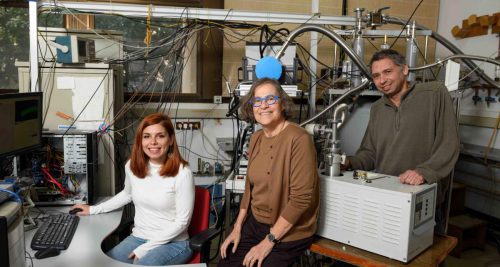The Weizmann Institute scientists were able to identify, using an innovative method they developed, two well-defined closed states of the ends of Hsp90 proteins, and showed that the protein remains closed after its activation * The Hsp90 protein makes up 1-2% of all the proteins in our body and it interacts with more than 200 proteins others

Like many other proteins in our body, Hsp90 unfolds and takes shape following chemical changes in the living cell. Despite its high prevalence in our cells and its vitality for a variety of processes that take place in them - until now it was not known exactly how the structure of Hsp90 changes in response to different scenarios. Recently, Weizmann Institute of Science scientists were able to observe these structural changes using an innovative method they developed. The results of the research, published in the scientific journal "Records of the American Academy of Sciences" (PNAS), may contribute both to the study of the action of this central protein and to the development of drugs targeting it.
The Hsp90 protein helps other proteins throughout their life cycle: as a "chaperone", it allows new proteins to fold into their proper spatial structure; As a "heat shock protein" (hence its name - Heat Shock Protein), it stabilizes other proteins in response to stress conditions; At the end of their journey, it is also involved in the breakdown of proteins - and under certain circumstances, it may even help cancer cells to thrive. This versatile protein is a dimer - a structure consisting of two separate but identical molecules. Each of the two molecules that make up the dimer has three parts: one of the three parts - the one by which the two molecules are connected to each other - is relatively fixed, while the other two parts are flexible and can open or close as needed. In order for these parts to close, energy is required in the form of ATP - the molecule that provides energy for all known life forms on Earth. In the process of breaking down ATP, known as hydrolysis, an ATP molecule is bound to a protein with the help of a magnesium ion; This binding causes ATP to lose one of its phosphate groups and in the process become ADP.
Scientists have long understood that the closed configuration is necessary for Hsp90 to activate, but it was unknown whether the protein remains closed after the chemical reaction with ATP or if it reopens when the reaction is over. This question touches the heart of the protein's action and is also essential for the development of drugs that target it. Previous studies that have attempted to answer this question have produced conflicting or inconclusive results. Prof. Daniela Goldfarb from the department of chemical and biological physics at the institute is one of the leading experts in the method for studying the dynamics of large and complex proteins, such as Hsp90. The method involves attaching a pair of small paramagnetic molecules, which serve as tiny magnetic tags, to points on the protein - and measuring the distance between these tags using electron magnetic resonance (EPR). This method makes it possible to measure the distance between pairs of tags, thus creating a map of the movement of the proteins and the structural changes that occur in them. More importantly, this method makes it possible to study proteins in their natural environment - inside living cells.
Despite all its advantages, this method has so far failed to allow good observations of the open/closed configurations at the ends of the Hsp90 protein. The reason: being somewhat flexible themselves, the bonds connecting the tags to the protein molecule made it difficult for the researchers to distinguish between movement originating from the tags and movement originating from the protein itself. To overcome this setback, Prof. Goldfarb and a post-doctoral researcher in her group, Dr. Angeliki Gianolis, came up with an original idea that turned out to be successful: to replace the magnesium with another element - manganese; Manganese (and only it) can replace magnesium without disrupting the action of proteins. Although the activity of magnesium and manganese ions is the same, unlike magnesium, EPR systems are able to pick up the signal of the electron spin in manganese. More than that - unlike the magnetic tags, the manganese ion is embedded in the protein structure, so the measurement will not pick up excess movement other than the movement of the protein itself.
With the help of the structural proteomics unit team of the institute led by Dr. Shira Albeck, the researchers were able to answer the open question and show that in solution, Hsp90 does indeed remain closed after the initial chemical reaction, albeit in a slightly different configuration. "It was challenging to distinguish the manganese signals, but we were able to identify two well-defined closed states of the ends of the Hsp90 proteins, one with ATP and the other with ADP," says Prof. Goldfarb. "Thanks to the advanced equipment in our laboratory, measurements in high magnetic fields and the expertise of Dr. Akiva Feintoch, we were able to clearly outline the different distances between the two parts of the protein."
Since the chemical reactions involving ATP and magnesium are among the most common in living things, the method may prove to be useful in discovering the dynamics of other proteins as well. Regarding Hsp90, Prof. Goldfarb hopes that the new findings will advance the understanding of this essential protein and help develop drugs that limit its activity in cancer cells and other conditions.
The Hsp90 protein makes up 1-2% of all the proteins in our body and it interacts with more than 200 other proteins.

3 תגובות
fixed.
Dr. Akiva Paintoch is probably the son of Professor Paintoch, Electrical Engineering, Ben Gurion University of the Negev.
The topic itself is extremely interesting, but what happened to the editing? There are so many repeated sentences!